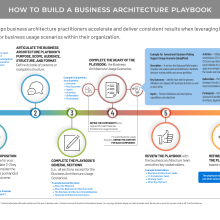Defining the value proposition of business architecture for your organization: Check. Building your business architecture baseline: Check. Building the team: Double-Check. Applying business architecture to some initial business usage scenarios and demonstrating its value: Check Again. Starting to build integration with and buy-in for the discipline: Check Check.
Now what?
As your business architecture team grows and as demand for your business architecture services increases, at some point you may want to seriously consider creating a business architecture playbook. While many teams are not even aware of what a business architecture playbook is, they often experience the challenges that can occur when one is lacking as the discipline scales within their organization.
This installment will break down the what, the why, and the how of building a business architecture playbook, in the usual StraightTalk style. Here goes.
First things first. What’s a business architecture playbook?
A business architecture playbook is a practitioner’s guide on how to create, use, and govern business architecture within an organization. The emphasis is on using business architecture in different business scenarios, though having at least an overview of other business architecture-related information all in one place can be helpful.
A business architecture playbook is also referred to by other names, such as a business architecture guide or methodology.
Who is the business architecture playbook for?
Business architecture practitioners. (Not business people.)
Some parts of your playbook may be valuable to other roles that you work closely with such as members of the strategy team or IT architects. (In fact, you can make this an enterprise architecture playbook instead of a business architecture playbook – and many organizations do.)
The playbook is usually stewarded by the central business architecture team or Center of Excellence, but it can and should be used by all business architecture practitioners across an organization.
Do we really have to create our own playbook? Doesn’t one already exist?
For the best results, yes, each organization does indeed need to create their own business architecture playbook.
There are some methodologies available, but some are more enterprise architecture- or technology-focused, and some are proprietary. The BIZBOK® Guide is intentionally principle-based versus a prescriptive methodology – and for good reason considering the strategic nature of the business architecture discipline. (The closest methodology-related content is in Appendix B.1.)
In addition, the positioning, points of emphasis, and usage scenarios for business architecture can vary greatly from one organization to another. Creating your own playbook gives you the flexibility and freedom to make it relevant for your specific situation.
Why do we need a business architecture playbook?
Remember that business architecture is intended to be practiced as an enterprise discipline, and as a result there are two immutable principles. They are:
- There is one shared business architecture for an organization (unless it’s a conglomerate or other structure that warrants multiple business architectures).
- Business architecture practitioners utilize one shared methodology.
The business architecture playbook is all about #2 and provides the business architecture practitioners in an organization with a shared set of methods for practicing the discipline.
P.S. See StraightTalk Post No. 49 for more on these principles and the do’s and don’ts of establishing a business architecture practice.
Having a business architecture playbook will allow you to:
- Scale faster – The playbook is an excellent tool for onboarding and training new business architects that join your team. It also helps to facilitate team collaboration and best practice sharing on an ongoing basis.
- Deliver better – The playbook ensures that business architects deliver business architecture services (e.g., strategy translation or investment decision-making support) efficiently and consistently – and that those services also achieve the intended business outcomes. Consistency not only provides a uniform experience for the business architecture stakeholders and partners you work with, but also helps people learn firsthand what business architecture actually is and what it can do.
As a side benefit, the activity of creating your playbook can be quite valuable in and of itself. It brings the business architecture team together to really introspect on what they do, why, and how. It is also a great opportunity to initiate conversations with other teams to create clarity around responsibilities and interactions.
When should a business architecture playbook be created?
The major factor that drives the need for a business architecture playbook is the number of business architects within an organization. The larger your team, the more important a playbook becomes.
However, you can still create a very light-weight business architecture playbook to help guide even a small team of practitioners. Just make sure to keep it simple and focused on outcomes – and supported by a lot of collaboration and knowledge sharing.
What does a business architecture playbook include and how is it structured?
At a high-level, consider the following major sections for your business architecture playbook:
- About the Playbook – A general section that describes the playbook itself (e.g., audience, purpose, how to use it, etc.).
- About the Business Architecture Team – A general section that overviews the business architecture team (e.g., the value it delivers to the organization, how it is structured and positioned within a strategy execution context, etc.).
- The Business Architecture Knowledgebase – A general section that overviews the organization’s business architecture (e.g., reference to the ten business architecture domains in the BIZBOK® Guide, an overview of the organization’s business architecture baseline value streams and capabilities and where to access them, etc.).
- Business Architecture Usage Scenarios – This section is the heart of the business architecture playbook. There is a sub-section for each business usage scenario, which typically includes an overview/description, key outcomes, inputs, activities, deliverables, and participants. A simplified example of an Investment Decision-Making Support Usage Scenario is outlined below:
- Overview – A service that helps portfolio leaders visualize and analyze planned initiatives to facilitate decision-making within and across portfolios.
- Key Outcomes – Identify how well the planned initiatives are aligned with business direction as well as each other.
- Inputs – Planned initiatives and descriptions, capabilities, and objectives
- Activities – (1) Obtain initiative list (i.e., business case submissions) (2) Cross-map initiatives to objectives (3) Cross-map initiatives to capabilities (4) Assess each initiative for strategic alignment as well as gaps and overlaps with other initiatives (5) Visualize the results and share insights
- Deliverables – Planned Spend Capability Heatmap, Strategic Priority Capability Heatmap, Insights & Recommendations
- Participants – Portfolio Leaders, Business Case Sponsors/Submitters, Business Architects, IT Architects, Application Owners
- Business Architecture Governance – A general section that describes how all aspects of business architecture are governed. It describes how the playbook is governed as well.
In what format is a business architecture playbook typically delivered?
A business architecture playbook can simply be one Word document with a Table of Contents that practitioners use to navigate across different sections of content.
However, the options in our digital world today are many, so the tools and options for building your playbook are limited only by your imagination. For example, you can create an overall outline or navigation structure for the playbook and then allow people to access relevant content and media from there (e.g., videos, animations, illustrations, templates and tools, examples, etc.).
So, how do we build our own business architecture playbook?
Here are some key steps to building your business architecture playbook:
- Define the value proposition of business architecture for your organization and articulate 2-3 key business outcomes. Consider the specific business usage scenario(s) or service(s) for each outcome. If you are at the point of needing a playbook, you probably defined this a while ago when you established your practice. However, this is a good time to revisit them and revise or tighten them up as needed.
- Define the purpose, scope, audience, structure, and format of your business architecture playbook. Define your Table of Contents or navigation structure.
- Complete the general sections of the playbook. This includes all sections except for the Business Architecture Usage Scenarios.
- Complete the heart of the playbook: the Business Architecture Usage Scenarios section.
- Define the components to be captured for each Business Architecture Usage Scenario. For example, as mentioned above, this may include overview/description, key outcomes, inputs, activities, deliverables, and participants.
- For each Business Usage Scenario, define the content for each component.*
- Review the playbook with the business architecture team and other key stakeholders. For example, you may want to review it with your business architecture leader, the IT architecture team, the strategy team, and/or other key partners you work with.
- Refine and expand the playbook iteratively based on use. The playbook does not need to be perfect – just get it out there and start using it. Iterate, iterate, iterate.
* BTW, for business usage scenarios related to translating strategy into initiatives, the stages of the strategy execution path provide an excellent framework to organize the content for each of these components.
And here’s a handy diagram to summarize all of that.
Anything else?
Very important: your business architecture playbook should ensure that outcomes are achieved – not that steps are followed. Don’t let a good thing become the ultimate thing.
Resist the urge to make your playbook into an overly prescriptive, detailed, and complicated procedure manual. Instead, focus it on the intended outcomes supported by examples and continuous team knowledge sharing. The discipline of business architecture is strategic as is the role of a business architect. We’re focused on delivering business value and business outcomes, and that should always be our guiding light and ultimate goal.
More Good Stuff...
NOTE: You’ll see that this section is a little light in this installment, but that just means the topic is cutting edge!
Part 1, Section and 3.11, and Appendix B.1 of BIZBOK® Guide (Business Architecture Guild® membership required): The BIZBOK® Guide has some useful content on the role of business architecture in strategy execution. In particular, see Appendix B.1, which has some starter material that you can leverage for your own business architecture playbook.
How to Achieve Your Most Ambitious Goals (TED Talk): A must-watch TED Talk by Stephen Duneier on how to achieve your biggest goals using one little secret. This could actually change your life. It will definitely help with your New Year’s resolutions.

